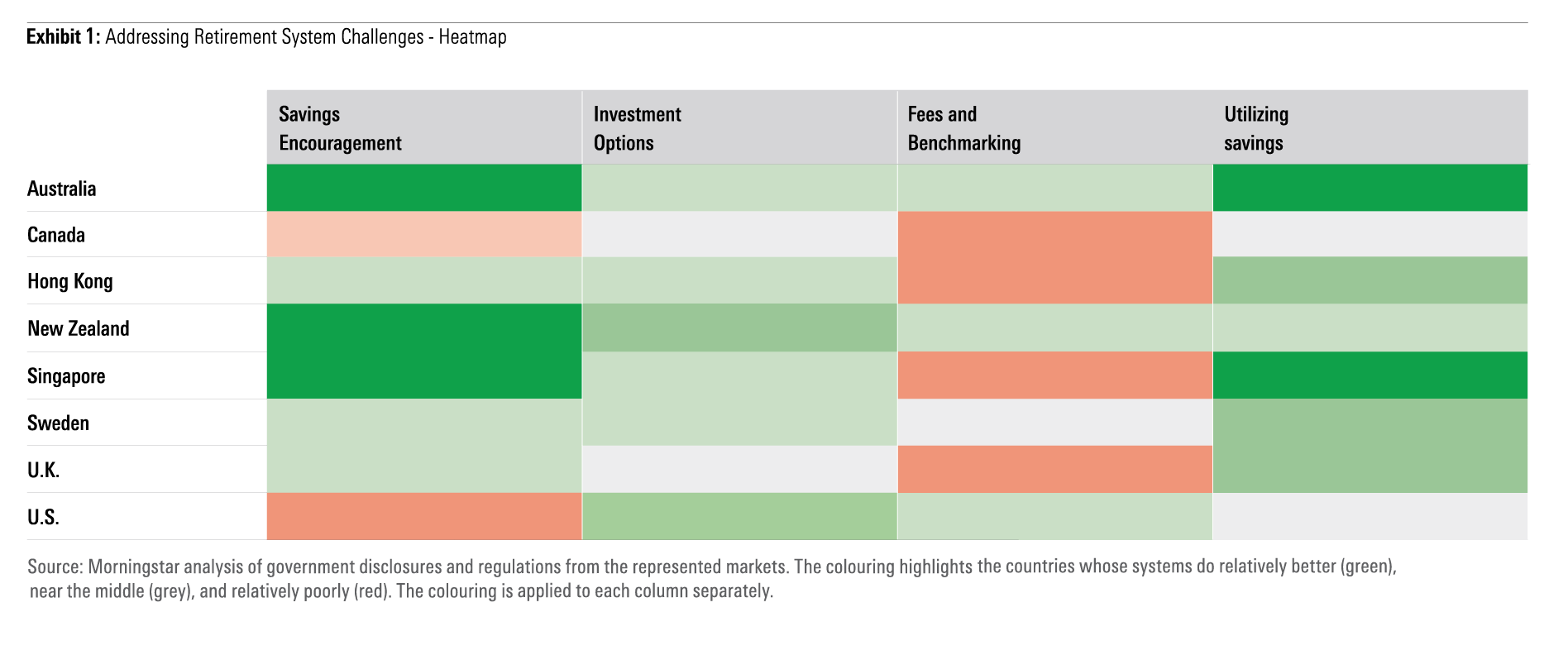
Investors in many markets are facing a common challenge: increasing responsibility for building savings to meet their needs in retirements that are lasting longer.
The fuel behind this fire comes from multiple sources: Public or social security pensions often provide no more than a basic retirement income, fewer companies are offering defined-benefit schemes to their workforce, and people are simply living longer.
Most countries operate some form of a three-pillar retirement framework:
- a social security pillar;
- occupational- or workplace-related savings; and
- personal or individual savings.
Optimizing each of the pillars and their interaction is crucial to ensuring positive retirement outcomes.
In a new paper, we specifically examine the second pillar and the workplace retirement systems in eight countries spanning the Americas, Europe, and Asia.
The countries—Australia, Canada, Hong Kong, New Zealand, Singapore, Sweden, the United Kingdom, and the United States—all have effective retirement systems that are often cited in independent studies as among the best-in-class frameworks in their regions. Rather than attempting to rank them based on differences, which might overly emphasize one approach, we have elected to observe and highlight both best practices and areas for improvement across four key components, illustrating these visually in a heatmap.

Singapore – A Strong, Centralized System
The uniquely broad reach of the Central Provident Fund, or CPF, provides a solid foundation for Singaporeans to save for retirement spending, healthcare, and housing costs.
On the savings front, the mandatory nature of the employer and employee contributions ensures sufficient funds are placed in the CPF, with the government providing additional support for lower-income workers. Additionally, workers do not have to worry about their accounts when changing jobs as it will move with them.
When it comes to investment options, there is a reasonable range of strategies available to workers. The self-awareness questionnaire provides learning modules and helps assess the investment risk employees should take based on their circumstances. Additionally, there are guardrails in the form of caps on allocation to riskier asset classes.
As for fees and benchmarks, the current fee caps and performance standards are a good starting point but could be improved. Fee caps currently are set by how risky the investment is, potentially impacting the investment selection process. Additionally, some of the caps are relatively high and could be limiting downward pressure from building.
In terms of utilization of savings, CPF assets are fairly inaccessible before retirement, only allowing for some withdrawal in the case of reduced life expectance or incapacitation. At retirement, individuals are notified on how to receive advice for planning their withdrawal. The drawdown is partially facilitated by an annuity scheme as well as a requirement that retirees set aside money for housing costs if they do not own a property.
Move to Defined-Contribution Plans Highlights Individual Responsibility
We find that the defined-contribution scheme is already thriving in some markets and at a more embryonic stage in others. In large part, this is shaped by the extent to which social security pension schemes provide, or have historically provided, a significant proportion of individuals’ retirement income.
A key tenet of the move to defined-contribution plans is that investment risk is put squarely on individuals. On top of that, workers must navigate a complex web of rules and options to optimize their savings. Getting unconflicted fiduciary advice to workers and retirees cost-effectively is a resulting challenge that still eludes most countries.
How Much Choice Is Too Much in Retirement Savings?
While choice is good, especially for experienced investors, too much choice is counterproductive, particularly for inexperienced investors. Some countries are better than others at optimizing plan choices so that participants are more likely to select a high-quality, low-fee investment or be defaulted into such an option.
In the same way that workers can be faced with too much choice within a plan, it’s also easy for them to accumulate multiple workplace plans and for that fragmentation to erode their savings. Minimizing the number of separate plans that individual workers have helps lower costs and increases engagement. Countries have tried various approaches, such as plan-follows-member, consolidating legacy plans into a “paid-up” plan, and auto-transferring small orphaned plans to an individual’s current or central plan.
How Countries Aim to Get People Saving Earlier
In the countries that have adopted them, auto-enrollment programs have been very effective at getting more people saving earlier. Plus, incremental changes to the programs continue to enhance the experiences of more workers. We find a growing number of examples seeking to engage members as retirement approaches but a dearth of initiatives to engage younger people in retirement saving.
The long-term nature of retirement saving can paradoxically create a savings disincentive for workers deterred by introducing a barrier to accessing their savings. Some countries alleviate this to different degrees by allowing early access to retirement savings in certain circumstances, but there is a delicate balance between this and preventing people from depleting their retirement income by using too much for other purposes.
Reducing Complexity as a Maxim
A common challenge we observed across heterogeneous retirement frameworks is complexity. They generally operate within complex rules and offer investment options that are not necessarily intuitive to inexperienced investors. Together, these factors make it challenging to ascertain how best to both accumulate, and then decumulate, retirement savings.
Overall, the hallmarks of the best-placed workplace schemes are government-mandated contributions; savings incentives, such as tax breaks or government contributions and employer-contribution-matching programs; and transparent oversight or benchmarking of scheme funds’ performance and costs.









:quality(80)/cloudfront-us-east-1.images.arcpublishing.com/morningstar/EC7LK4HAG4BRKAYRRDWZ2NF3TY.jpg)


.png)








